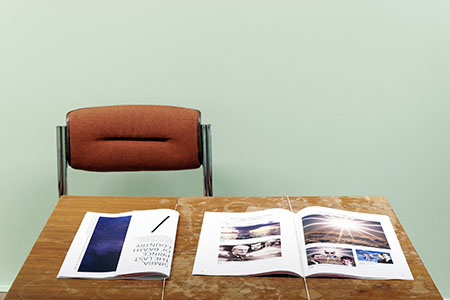Enacting Populism in its Mediæscape

Populism seems to be on everybody’s mind in Europe, no more so than in the lead-up to the French presidential elections in May. The term ‘populist’ popped up day after day in the headlines to denounce the political agendas of politicians as far apart as Marine Le Pen, Jean-Luc Mélenchon and Nicolas Sarkozy. More a political style than an ideology, populism can exploit latent fears about anything from the rise of globalization, European Union enlargement, migration and unemployment to social insecurity, offering one-dimensional responses to a complex situation.
To use populism as a way to better understand democracy was the starting point for curator Matteo Lucchetti’s ‘Enacting Populism’, a research project that started in Antwerp at the end of 2010 and culminated this spring in an exhibition featuring 12 artists and collectives at the Kadist Art Foundation. The initiative was undoubtedly timely, scheduled to take place two months before the first round of French elections, mirroring populist strategies and profiting from the feverish campaign atmosphere. Lucchetti further echoed this effect by transforming the gallery space into a fictional campaign office, with the walls painted in an administrative green and Soviet furniture borrowed from Paris’s Communist Party headquarters.
The show essentially resembled a discursive space more than an exhibition, presenting art works that comprise or mimic forms of documentation such as posters, extracts of political speeches, pseudo-political administrative documents and flyers. As its titled suggested, ‘Enacting Populism in its Mediæscape’ played itself to a certain degree by acting out the role of a populist exhibition. However, this effect was rapidly exhausted, as it reached the inevitable limit of endlessly re-enacting the grammar and imagery the show claimed to denounce.
One of the consequences of that approach was that the art works required a great deal of time, attention, reading and additional explanation to be consumed, going against populism’s principle of appealing to people’s emotions through simple and effective communication strategies. One exception was a video by Oliver Ressler, which was only visible at night, when it was projected onto the closed façade of the gallery space. The footage in Robbery (2012) literally shifts from ‘night time robbery’ – images of shops being looted during England’s social unrest – to ‘daytime robbery’: Sarkozy and Angela Merkel misappropriating government funds to save banks. The connection needs no further explanation.
Other works also stood out. Danilo Correale’s project Re-designing Fear – People’s Party Spectacular (2011) worked around the recurrent populist discourse of hope for change. The artist introduced 5,000 scratch-cards into circulation in Antwerp, which, when scratched off, revealed familiar xenophobic slogans. A video installation and publication by the collective Foundland, entitled Simba, The Last Prince of Ba’ath Country (2012), formed an archive of pro-Al-Assad propaganda images that shows how a country’s political imagination can be falsified through the Internet.
Did ‘Enacting Populism’ manage to go beyond simulation and live up to Lucchetti’s aim of trying ‘to articulate positive and emancipatory means through images’ to create a potential social change? These are ambitious goals and not many of the projects on view were able to successfully develop this activist potential. Ernesto Laclau introduced the exhibition with a lecture and an interview published in Le Monde in which he moved beyond negative connotations linked to the xenophobic European populist discourse, highlighting its positive outcomes in Latin America. Claiming that ‘without a certain dose of populism, democracy is unthinkable today’, he provided one of the exhibition’s theoretical goals of finding positive populisms. But Laclau’s ideas created expectations that went somewhat unfulfilled, as there were no examples in the show of populism’s ‘positive antagonisms’. I would have liked to see works that were more conscious of their own involvement in the dynamics of populism, over-complicating rather than dismantling and analyzing its discourse.
In spite of these unavoidable shortcomings, ‘Enacting Populism’ remained a thorough investigation of a theme that can be endlessly re-enacted through exhibitions and in the public debate. In 2005, together with Lars Bang Larsen and Nicolaus Schafhausen, I tried my hand at dealing with populism through the prism of contemporary art in the exhibition ‘Populism’. I was struck then by the claim that the 21st century was destined to be the ‘populist era’, much like the 20th century had been the ‘totalitarian era’. The interest aroused now by this new show suggests that the topic is becoming increasingly timely and that populism is here to stay.















